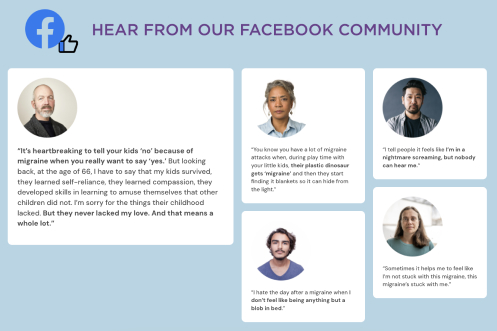For many patients, migraine is associated with other illnesses such as:
- Depression
- Anxiety
- Stroke
- Irritable bowel syndrome
- Epilepsy
- Hypertension
These illnesses are now recognized as being common migraine comorbidities. The term comorbidity is used when two illnesses occur at a greater than coincidental rate than what is seen in the general population. This suggests that at some level, the two illnesses are interrelated.
When two conditions are found in the same person but the incidence is not greater than what is seen in the general population, these are referred to as coexisting conditions. For example, a patient may have migraine and diabetes. There is no evidence suggesting that these two conditions exist in a single patient more frequently that these conditions exist in individual patients in the general population. In contrast, migraine and depression appear to be comorbid because they occur together more often than they occur in individual patients in the general population.
Understanding the association of migraine with other health conditions is an important part in providing optimal care. Once a person has been diagnosed with migraine, it is important to consider that other medical conditions may also be present. This is why a complete medical history and exam is needed in all patients receiving a work-up for migraine.
When a comorbid condition is identified along with migraine, treatment now becomes more complex because there are two separate conditions to manage, and both conditions may be interrelated.
For example, if someone is struggling with a bout of difficult depression, they may find their migraine attacks become worse. If depression improves, they may find that their migraine also improves. For this reason, migraine and potential comorbid conditions need to be accurately diagnosed.
If migraine and another associated illness is considered, there are several easy steps to you can take.
Diagnosis:
- Get an accurate diagnosis for the type of headache you may have and the existing comorbid or coexisting condition.
- Treatment: Get a clear treatment plan. For some patients, a single medication may successfully manage both conditions, while others may need more than one medication.
- Monotherapy: For example, some patients with depression may be well controlled with an antidepressant that is also effective in reducing migraine frequency.
- Polytherapy: However, it is important to acknowledge that for many patients, polytherapy is the optimal approach. This means that each condition can be treated independently using separate medications with individual dosing regimens. This may take some time getting used to the routine of managing two conditions using different medications.
- Lifestyle: Often lifestyle factors are an important part of managing any medical condition, and migraine is one of these. Patients with migraine will benefit from monitoring and addressing lifestyle factors that may be making migraine or other conditions worse. Below are common lifestyle factors to consider as playing a potential role in migraine and associated cormorbidities:
- Maintain routine sleep and appropriate amounts of sleep.
- Maintain routine eating and drinking habits. Prolonged periods of fasting, dehydration, or hyperglycemia (too much sugar) may all make migraine or other conditions worse.
- Limit caffeine, alcohol and other nonprescription medications. Use of any medication should be discussed with the health care provider.
- Follow treatment plans as instructed. Any need to make modifications to the treatment or dosing plan should be addressed with the physician first.
Overall, many individuals find that they have multiple health conditions at the same time. It is important to realize this is NOT unusual, rather a common occurrence. Seeking an accurate diagnosis and initiating treatment is the most important step to improving your overall health.
This article is a legacy contribution from the American Headache Society Committee for Headache Education (ACHE) and the Fred Sheftell, MD Education Center.
Other Co-Morbid Conditions
Co-Morbidity: Helping Yourself Help Your Headaches
Robert A. Nicholson, PhD
When you talk with your provider about your headaches, do you ever wonder why they also ask about other issues in your life, such as: “Are you sad?”…”Do you get anxious?”…”How’s your sleep?”…”What triggers your headaches?”
Do you ever wish they would just give you a useful medication and focus on the headache? If headaches are the only issue for you, then you are in the minority. Most headache patients needing a provider deal with more than just headaches. This is due to an increased link between headache and several other disorders. This increased connection is called “co-morbidity.” It turns out that most headache patients have one or more co-morbidity.
Think about what kinds of conditions are more common than chance among people you know with headache. What comes to mind? It turns out that the most common are sleep problems, especially insomnia. Anxiety, depression, bipolar II, and posttraumatic stress disorder (PTSD) are also very frequent in headache patients. These kinds of links with headache are called psychological, psychiatric or behavioral comorbidities. In this ACHE issue, we discuss some of the most common headache-psychological links.
How common are these comorbidities? Well, it turns out that nearly three out of every ten people with migraine have depression. As many as five out of ten have anxiety. Recently, we have learned more about the impact of childhood abuse and maltreatment on headache. Recent research has told us that as many as three out of ten people with severe migraine have PTSD and many have been abused. Among behavioral comorbidities, problems with sleep are likely the most problematic along with difficulties coping with stress.
But why? What causes these comorbidities to be so common among persons with headache? It turns out that sharing of many of the brain’s message systems is the answer. Brain regions and messengers that communicate information about mood also determine how the body sleeps and copes with stress. These, in turn, involve communication that leads to headache and feeling pain.
The brain also uses certain chemicals called neurotransmitters to communicate (if you’ve seen any commercial for a medication on TV you have probably seen an example of how the brain uses these chemicals to communicate). In people who struggle with mood, the communication doesn’t work as well as it is supposed to work. In people with headache, some of these same areas of communication also don’t work as well as they are supposed to work.
In addition, research has shown that there is likely a genetic reason for why someone with headache is more likely to have depression or other mood issues.
Finally, people who have headaches have a brain that is highly sensitive to changes that can occur within their body. Examples include hormones, responding to stress, not sleeping well, and skipping meals.
They are also sensitive to changes from outside their body. Examples include weather, light, smoke and perfumes. This sensitivity appears to be due to an “over alert” or “hyperexcitable” brain. It turns out that this may also be true among people with comorbid mood disorders. We also know abused people are more sensitive to the outside environment as well.
In this issue of ACHE, we write about these topics. Most of these topics were provided to specialists interested in headache management at the 2010 American Headache Society Annual meeting. They are rewritten and edited for your benefit here.
The first article, written by a psychologist seeing headache sufferers daily, addresses whether you might be a good candidate for a psychological referral, how to talk about getting a referral, and what to expect on your first visit.
The next article discusses depression and anxiety, two of the biggest psychological issues faced by people with headache. This article was written by two of the leading experts in the issues of mood and headache, and both of them use their own experiences as clinicians to help you better understand this topic.
The article on PTSD and abuse discusses how abuse and PTSD are more common in headache. It tells why those who experience PTSD and abuse as children are at greater risk for having headaches later. We are honored to have one of the leading researchers in this area and one of the top headache psychologists in the country write this article.
Next, we have an article on the connection between sleep and headache. The author is the leading expert on sleep and headache in the USA and she built on her research and clinical experience to write this article.
Finally, the editor of this newsletter, a practicing headache specialist, offers his ABC’s on behavioral self care. The intent is to maximize success and minimize the problems discussed herein.
As you read through this issue of ACHE, we hope that it helps you better understand these issues. We hope you will obtain better tools to use if psychological comorbidities apply to you.
Robert A. Nicholson, PhD, Associate Professor, Dept. of Neurology & Psychiatry, Saint Louis University School of Medicine; Research and Methodology Consultant, Mercy Health Research/Ryan Headache Center, St. Louis, MO.









































































